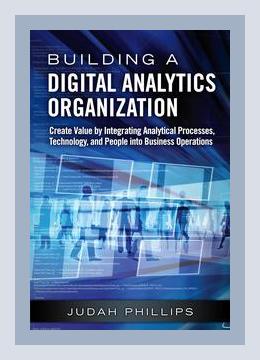Technology and Digital TransformationE-commerce
Introduction
Rudy Mendoza’s 2015 book “Building a Digital Analytics Organization” serves as a comprehensive guide for businesses looking to harness the power of digital analytics. The book is essentially a blueprint that elaborates on how companies can build a scalable and effective analytics organization to drive growth and competitiveness in the e-commerce sector. This summary will unfold the key aspects of the book, enriched with concrete examples and actionable advice.
Chapter 1: The Importance of Digital Analytics
Mendoza begins by stressing the importance of digital analytics in modern business. In today’s digital age, data-driven decision-making is no longer optional; it’s a necessity.
Example:
He discusses how companies like Amazon utilize data analytics to optimize their supply chain, personalize customer recommendations, and enhance user experience.
Actionable Advice:
Begin with an analytics audit to understand what data you currently have, what you are missing, and how it can be better utilized. Start small with key performance indicators (KPIs) relevant to your business.
Chapter 2: Building the Team
Creating a digital analytics organization requires the right mix of talent. Mendoza identifies key roles such as data scientists, analysts, and data engineers.
Example:
He describes how Netflix employed a specialized team of data scientists and engineers to analyze viewer data, leading to the development of their recommendation algorithm.
Actionable Advice:
Conduct a skills gap analysis within your current team and identify the roles you need to hire for. Invest in training and certifications to upskill existing employees.
Chapter 3: Choosing the Right Tools
Selecting the right tools and platforms is critical for analytics success. Mendoza breaks down popular tools like Google Analytics, Adobe Analytics, and Tableau.
Example:
He explains how Coca-Cola used Google Analytics to track online campaigns’ effectiveness across different demographics and regions.
Actionable Advice:
Audit your current tools and identify gaps. Evaluate new tools based on scalability, ease of use, and integration capabilities with your existing technology stack.
Chapter 4: Data Collection and Management
Effective data management is the backbone of any analytics organization. The book delves into data warehousing, data lakes, and ETL (Extract, Transform, Load) processes.
Example:
Mendoza highlights Uber’s use of a data lake to manage their enormous datasets, enabling real-time analytics and operational insights.
Actionable Advice:
Implement a centralized data repository using data lakes or warehouses. Ensure that data is clean, accurate, and accessible for analysis.
Chapter 5: Analyzing the Data
Once the data is collected and managed, the next step is analysis. Mendoza discusses various analytical techniques including descriptive, diagnostic, predictive, and prescriptive analytics.
Example:
He illustrates how Starbucks employed predictive analytics to identify customer purchasing patterns, helping them tailor marketing campaigns effectively.
Actionable Advice:
Adopt a layered analytics approach starting with descriptive statistics to understand the past, then move to predictive and prescriptive analytics to forecast and strategize future actions.
Chapter 6: Data Visualization
Data visualization is essential for making data comprehensible and actionable. Mendoza elaborates on best practices for creating dashboards and reports.
Example:
He presents case studies of companies like Airbnb using dashboards to track key metrics across different departments, facilitating quick decision-making.
Actionable Advice:
Invest in robust data visualization tools such as Tableau or Power BI. Design custom dashboards for different organizational roles, ensuring they highlight the most relevant KPIs.
Chapter 7: Driving Organizational Change
Building an analytics-driven culture involves changing existing mindsets and processes. Mendoza discusses tactics for driving organizational change through leadership and communication.
Example:
He references how General Electric (GE) altered its corporate strategy to become more data-centric, focusing on data-driven decision-making across all levels.
Actionable Advice:
Create a clear communication strategy to educate employees about the importance and benefits of data analytics. Show quick wins through pilot projects to build momentum.
Chapter 8: Case Studies
The book includes detailed case studies from leading companies like Google, Amazon, and Procter & Gamble. These examples underscore the various challenges and successes experienced by these organizations in their analytics journeys.
Example:
Mendoza describes how Google continuously iterates its analytics strategies to remain ahead, such as using complex A/B testing to refine product features.
Actionable Advice:
Study these case studies to understand both strategic and tactical initiatives that could be adapted to your business context. Benchmark against industry leaders to identify areas for improvement.
Chapter 9: Ethics and Compliance
Ethical considerations and compliance are crucial when handling data. Mendoza emphasizes respecting user privacy and adhering to regulations like GDPR.
Example:
He draws on Facebook’s data breaches and the ensuing controversy as a warning of what can go wrong when data is mishandled.
Actionable Advice:
Implement robust data governance policies. Regularly audit data usage and ensure compliance with relevant laws and regulations.
Chapter 10: Future Trends
Finally, Mendoza looks ahead at future trends in digital analytics such as AI, machine learning, and real-time analytics.
Example:
He predicts the growing influence of IoT and how companies like Tesla are using real-time data analytics to improve vehicle performance and safety.
Actionable Advice:
Stay updated with technological advancements and continually invest in learning and development. Experiment with AI and machine learning models to see how they can add value to your business.
Conclusion
“Building a Digital Analytics Organization” by Rudy Mendoza is a rich resource for anyone looking to establish or enhance their digital analytics framework. The book covers a wide array of topics, from the foundational aspects of team building and tool selection to the advanced facets of data ethics and future trends. For every major point, Mendoza provides not only theoretical underpinnings but also practical examples and actionable steps to help readers implement his advice in real-world scenarios.
By following Mendoza’s guidelines, businesses can build a robust digital analytics organization that not only responds to the present needs but is also well-prepared for future challenges and opportunities.
